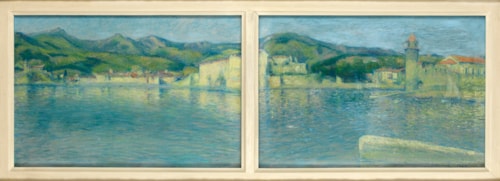
Achille LAUGÉ
Arzens 1861 - Cailhau 1944
Biography
Much of Achille Laugé’s childhood, and most of his career, was spent in Cailhau, in the Aude. He began his artistic training at the Ecole des Beaux-Arts in Toulouse, where he met his lifelong friend the sculptor Antoine Bourdelle, before entering the Ecole des Beaux-Arts in Paris in 1882. Enrolled in the studio of the painter Alexandre Cabanel, Laugé soon met and befriended another sculptor, Aristide Maillol, who he introduced to Bourdelle and with whom he later shared a studio. A pencil portrait of Bourdelle was Laugé’s first exhibited work, shown at the Salon des Artistes Français in 1884. Two years later, in 1886, Laugé left Paris and returned to live and work in the South of France for the remainder of his long career.
Laugé’s early adoption of the pointilliste technique in his paintings has led to some debate as to its sources. While two childhood friends of the artist, the journalist Achille Astré and the influential politician Albert Sarraut, both claimed that Laugé developed the distinctive divisionist technique on his own, without any knowledge of the work of Georges Seurat and his circle, this must be seen as highly unlikely. During Laugé’s stay in Paris between 1881 and 1886 he can hardly have failed to come into contact with the avant-garde work of the Neo-Impressionists. At the Salon des Indépendants of 1886, for example, Seurat’s great painting of A Sunday Afternoon on the Grande Jatte was exhibited to immense popular interest and critical attention, alongside works by Paul Signac, Henri-Edmond Cross and other Neo-Impressionist artists. It may certainly be said, however, that after his return to the South Laugé’s style developed independently from that of the Seurat circle in Paris, and that he came to develop a particular brand of Neo-Impressionism that was distinctively his own. His pointilliste technique became progressively looser and broader around the turn of the century, however, and from around 1905 onwards his paintings were executed more rapidly, with larger dots of colour.
Laugé only rarely exhibited his work. In 1894 he sent five paintings – two still lives and three portraits – to the Salon des Indépendants, while the same year he was included in a group exhibition in Toulouse, alongside Bonnard, Denis, Valloton, Vuillard, Toulouse-Lautrec, Serusier and others. These contributions to public exhibitions were, however, more the exception than the rule. Laugé’s paintings were repeatedly rejected by the Salon juries in Paris; in 1900, for example, the Salon Nationale des Beaux-Arts rejected two paintings he had submitted; an interior scene now in the Musée du Petit Palais in Geneva, and a portrait of the artist’s wife, today in the Musée des Beaux-Arts in Grenoble. In 1902, however, he was again included in an exhibition in Toulouse, where among several paintings was a Paysage de la Gardie, now in the Musée d’Orsay.
Around 1905, to allow himself the opportunity of working directly from nature, Laugé built a small caravan, with a skylight and large windows, from which he would paint the Languedoc countryside he knew so well. He worked in both oils and pastel, with a precise technique and a careful study of tonal values. His friend Antoine Bourdelle noted that ‘Laugé’s art is one of great sensitivity and controlled reason; he is a master of light.’ His serene landscapes were also greatly admired by the critic Gustave Geffroy, who wrote of his paintings that ‘everything is filled with sunlight, but through a harmonious prism; to an acute and discerning vision is added the delicate ethereal quality of imagination.’ Laugé received almost no public commissions, apart from several designs for tapestries to be produced by the Gobelins factory, commissioned by Geffroy between 1919 and 1914. In 1919 Laugé obtained what was to be his only commission for a mural decoration, for a series of landscapes and floral scenes in several rooms in the house of a M. Castel, mayor of Lézignon. The project was left incomplete, however, and no trace of the work survives.
Laugé almost never left the Midi, and only rarely exhibited his paintings in any of the Parisian art galleries. (After one of these rare exhibitions, the critic Camille Mauclair noted that ‘Achille Laugé…having at last decided to show in Paris the works created in the seclusion of regional life, has had a rightful success.’) His relative isolation meant that Laugé’s work remained largely unknown to most of the scholars, critics and collectors of his time. Much the same is true today, although paintings by the artist now hang in the Musée National d’Art Moderne alongside Neo-Impressionist works by Seurat and Signac. The largest surviving group of works by Laugé is today to be found in the Musée des Beaux-Arts in Carcassonne, the nucleus of which is a group of eighteen paintings, pastels and drawings given to the museum in the 1970’s by the artist’s daughter Juliette.


